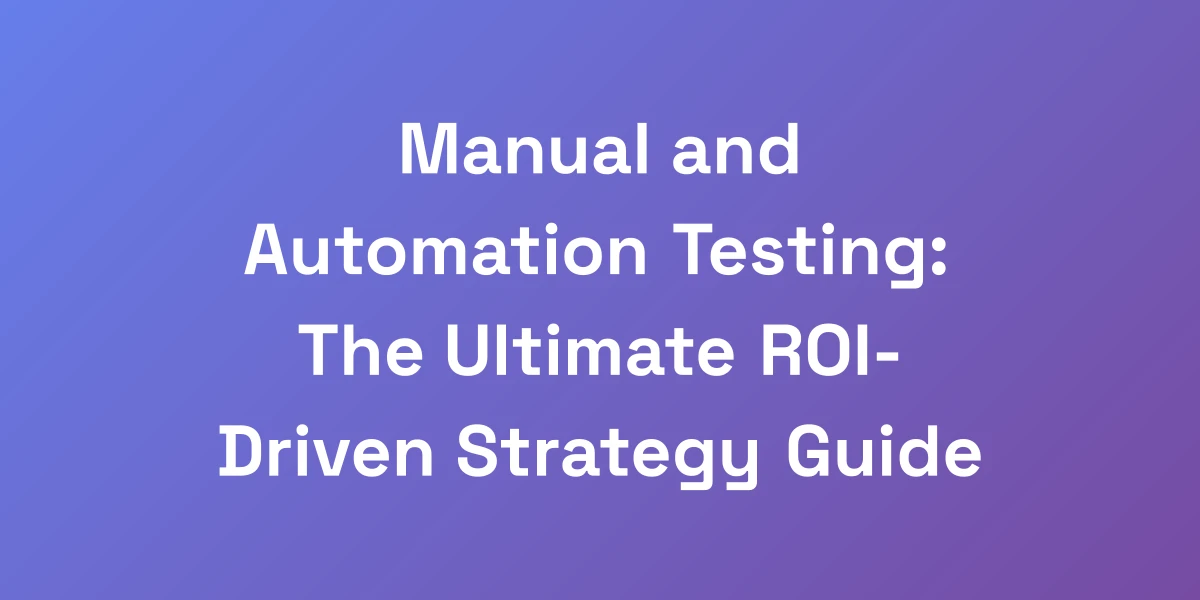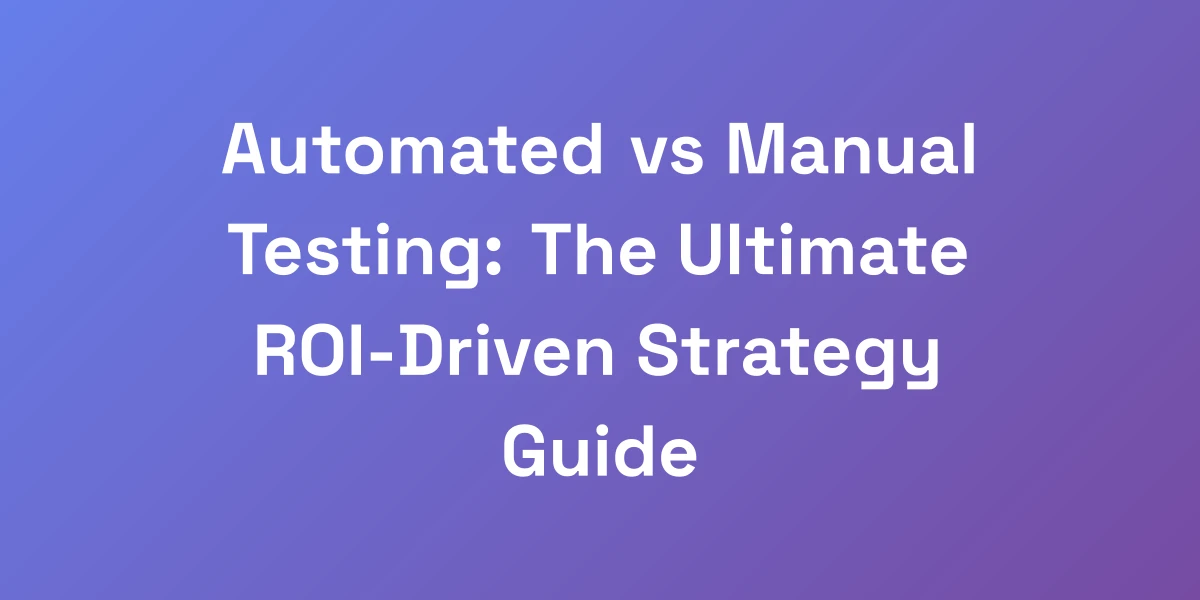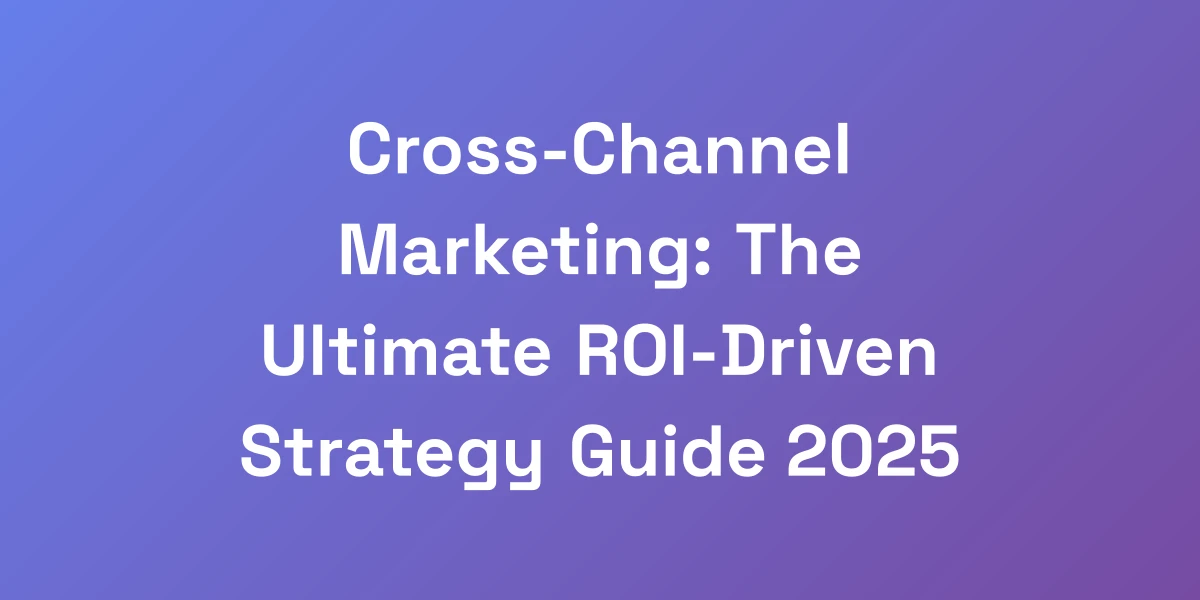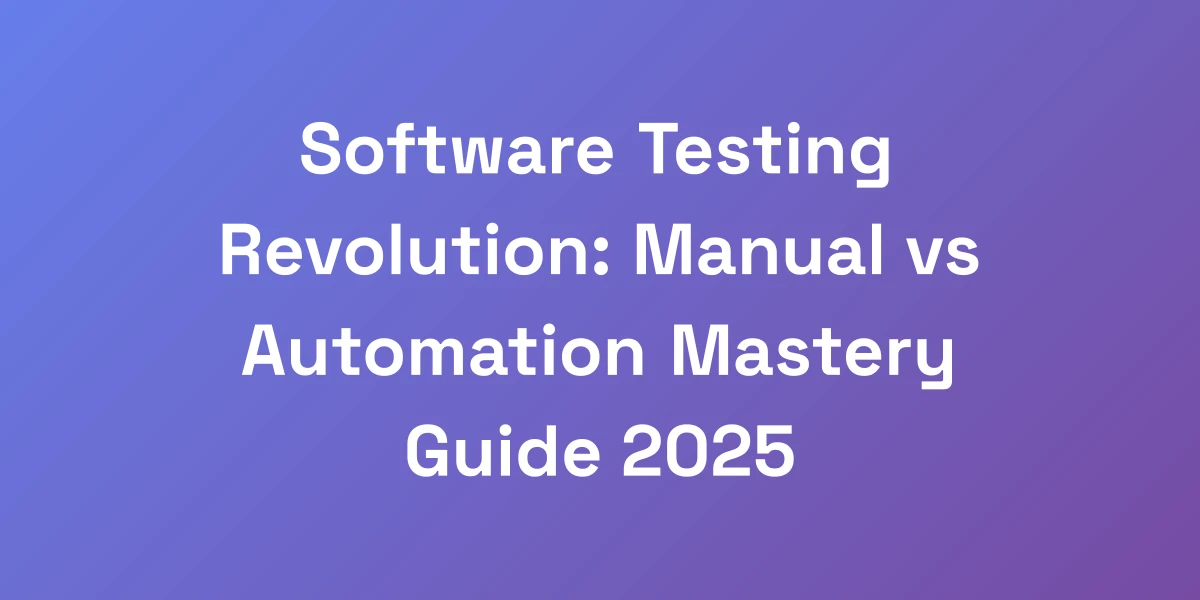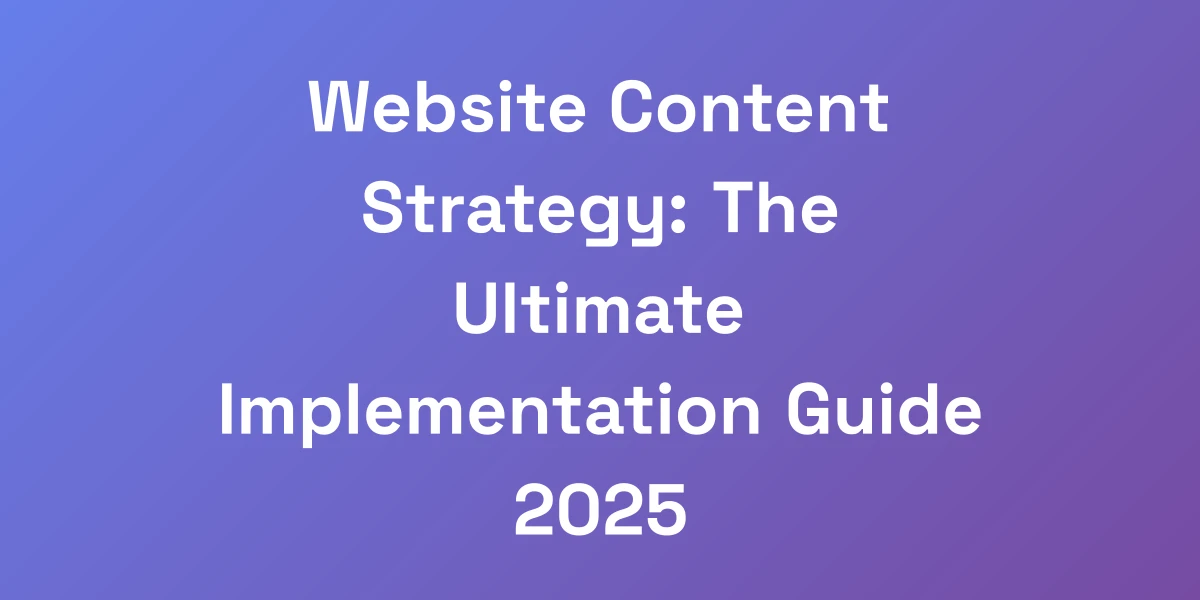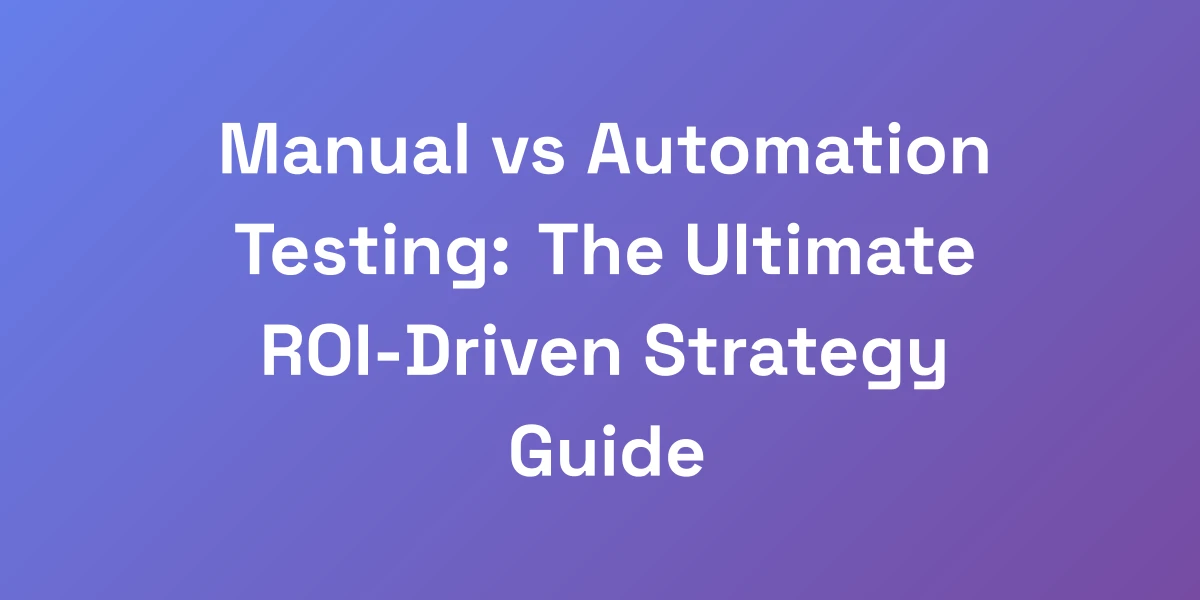
Manual vs Automation Testing: The Ultimate ROI-Driven Strategy Guide
Mar 12, 2025 | By [email protected]
Why Most Companies Waste Money on Testing (And How to Fix It)
Let me hit you with some truth: 90% of companies are bleeding money by mismanaging their testing strategy. They’re either stuck in the manual testing stone age or throwing cash at SEO optimization automation without a game plan.
Here’s the reality – it’s not about choosing one over the other. It’s about leveraging both to maximize your ROI. In our years of scaling businesses, we’ve discovered that the real magic happens when you strategically combine manual and automation testing.
Let’s break down why your current approach might be costing you millions.
The Hidden Costs of Poor Testing Strategy
Think about it: Every bug that slips through the cracks isn’t just a minor annoyance. It’s a direct hit to your bottom line. Poor testing strategies can lead to:
- Increased Development Costs: Fixing bugs late in the development cycle is exponentially more expensive.
- Reputation Damage: A single high-profile failure can erode customer trust.
- Lost Revenue: Downtime, errors, and user frustration can drive customers straight to your competitors.
In essence, a flawed testing strategy doesn’t just waste money—it actively drains it.
Common Testing Misconceptions That Kill Profits
Are you falling for these myths?
- Automation Equals Success: Believing that automation alone can handle all testing needs. Automation is powerful, but it’s not a silver bullet.
- Manual Testing is Obsolete: Underestimating the value of human intuition and exploratory testing can leave gaps in your quality assurance.
- More Testing Means Better Quality: Quantity over quality? Not quite. Understanding the differences between manual and automated testing highlights why efficient testing is about smart coverage, not sheer volume.
These misconceptions can steer resources in the wrong direction, leading to squandered investments and subpar product quality.
The Business Impact of Testing Failures
Imagine launching a product plagued with bugs. The fallout isn’t just an upset customer—it’s tangible business harm:
- Financial Loss: Direct costs of fixing issues post-launch can skyrocket your budget.
- Customer Churn: Dissatisfied users rarely become repeat customers.
- Brand Erosion: Negative reviews and word-of-mouth can tarnish your brand’s reputation long-term.
Testing failures can dismantle years of hard-built trust and investment in mere months.
Understanding Your Testing ROI
How do you measure the effectiveness of your testing?
Return on Investment (ROI) in testing isn’t just about costs saved; it’s about the value added through quality improvements.
- Cost Savings: Reduction in post-release bugs directly translates to lower maintenance costs.
- Efficiency Gains: Streamlined testing processes mean faster time-to-market, giving you a competitive edge.
- Enhanced Quality: Higher quality products lead to better customer satisfaction and retention.
Evaluating ROI involves looking beyond the immediate expenditure and focusing on long-term gains. To effectively calculate the ROI of test automation, consider both direct savings and value improvements.
Quick Wins for Immediate Cost Reduction
Ready to cut costs without sacrificing quality? Here are some actionable tips:
- Prioritize Test Cases: Focus on high-impact areas that are most likely to fail.
- Implement Regression Testing: Ensure new changes don’t break existing functionalities.
- Adopt Continuous Integration: Automate early testing to catch issues sooner.
Implementing these strategies can provide immediate relief to your testing budget while laying the groundwork for sustained efficiency.
The Strategic Framework for Combining Manual and Automation Testing
Stop thinking about testing as a binary choice. Instead, think of it as a strategic investment portfolio. Just like you wouldn’t put all your money in one stock, you shouldn’t put all your testing eggs in one basket.
We’re going to show you the exact framework we use to determine which tests should be manual and which should be automated. This isn’t theory – it’s a battle-tested approach that’s saved companies millions in testing costs while improving product quality.
The 80/20 Rule of Testing Efficiency
The 80/20 rule applies perfectly here. Identify the 20% of tests that cover 80% of your potential issues.
- Critical Path Testing: Focus automation on core functionalities that are essential for your product’s success.
- Frequent Regression Tests: Automate tests that need to be run repeatedly across different builds.
By targeting these areas, you maximize your testing efficiency and ROI without spreading resources too thin.
Decision Matrix for Test Case Selection
Creating a decision matrix helps in evaluating which test cases should be automated and which should remain manual.
- Frequency of Use: High-frequency tests are prime candidates for automation.
- Complexity: Highly complex tests might benefit more from manual testing initially.
- Criticality: Tests that are critical to business operations should lean towards automation for consistency.
Using this matrix ensures that your team focuses on the right tests in the right manner, optimizing both time and resources.
Risk Assessment Framework
Assessing risk is crucial in deciding your testing strategy.
- Impact Analysis: Determine how a defect in a particular area would impact your business.
- Likelihood of Failure: Evaluate how likely a component is to fail based on historical data.
- Mitigation Strategies: Develop strategies to address the most significant risks first.
By understanding the risks, you can prioritize testing efforts where they’re needed most, ensuring maximum ROI. For insights into the failure analysis and test equipment market, consult industry reports to inform your risk assessments.
Resource Allocation Strategy
Effective resource allocation ensures that your testing strategy is both efficient and effective.
- Skill Assessment: Evaluate your team’s strengths in manual and automated testing.
- Balanced Staffing: Allocate resources based on the chosen testing strategy, ensuring neither manual nor automation efforts are underfunded.
- Training and Development: Invest in training for both manual and automation testing to keep your team’s skills sharp.
Strategically distributing your resources prevents bottlenecks and maximizes the output of your testing processes. Understanding software testing team roles and responsibilities helps in effective resource allocation.
ROI Calculation Model
To truly understand the ROI of your testing strategy, use a structured calculation model.
- Initial Investment: Consider costs related to tools, training, and setup.
- Operational Costs: Include ongoing expenses like maintenance and updates.
- Benefits: Calculate savings from reduced defect rates and increased efficiency.
This model provides a clear picture of how your investment is paying off, guiding future strategic decisions. For a detailed approach on test data management ROI, refer to specialized resources.
Automation Testing: When and How to Scale It Right
Here’s the brutal truth about automation: most companies do it wrong. They automate everything they can instead of everything they should. The key is to identify high-leverage opportunities where automation provides exponential returns.
We’re going to show you the exact framework we use to determine which tests should be manual and which should be automated. This isn’t theory – it’s a battle-tested approach that’s saved companies millions in testing costs while improving product quality.
Stay updated with the latest automation testing market trends to ensure your strategy aligns with industry standards.
High-ROI Automation Opportunities
Not all test cases are created equal. Focus automation efforts on:
- Repetitive Tasks: Tests that need to be executed frequently benefit greatly from automation.
- Data-Driven Tests: Automated testing excels in handling large datasets and varied input scenarios.
- Performance Testing: Automation tools can simulate multiple users and load conditions more effectively than manual testers.
By targeting these high-ROI areas, you ensure that your automation efforts are driving significant value.
Tool Selection Criteria
Selecting the right automation tools is critical to your success.
- Compatibility: Ensure the tool integrates well with your existing tech stack.
- Ease of Use: The tool should be user-friendly to minimize the learning curve.
- Scalability: Choose tools that can grow with your testing needs.
- Community and Support: Robust support and a strong user community can be invaluable.
Choosing the right tool can make or break your automation strategy, so take the time to evaluate your options thoroughly, including auto SEO tools that might complement your testing frameworks.
Implementation Timeline
Rolling out automation testing requires careful planning.
- Phase 1: Assessment: Identify key areas for automation and set clear objectives.
- Phase 2: Tool Selection and Training: Choose your tools and train your team accordingly.
- Phase 3: Pilot Testing: Start with a small set of tests to evaluate effectiveness.
- Phase 4: Full Deployment: Scale up automation efforts based on pilot results.
Having a structured timeline helps in managing expectations and ensuring a smooth implementation process.
Cost-Benefit Analysis
Before diving into automation, conduct a thorough cost-benefit analysis.
- Initial Costs: Tool licenses, training, and setup expenses.
- Ongoing Costs: Maintenance, updates, and potential scaling costs.
- Benefits: Reduced manual labor, faster testing cycles, and higher defect detection rates.
Balancing these factors will help you determine whether the investment in automation is justified for your specific needs.
Scaling Automation Successfully
Once you’ve seen initial success, scaling your automation efforts is the next step.
- Standardize Processes: Develop standardized testing procedures to ensure consistency.
- Expand Tool Utilization: Integrate additional tools and technologies to cover more test cases.
- Continuous Monitoring: Regularly assess the effectiveness of your automation strategy and make adjustments as needed.
Scaling automation requires ongoing attention and refinement to maintain and enhance its benefits.
Manual Testing: The Human Element That Machines Can’t Replace
Let’s get something straight: manual testing isn’t dead. In fact, for certain scenarios, it’s irreplaceable. The key is knowing exactly when human intuition and creativity deliver more value than automated scripts.
We’ll show you how to leverage manual testing for maximum impact while avoiding the common pitfalls that make it inefficient. This is about working smarter, not harder. Stay updated with the latest trends in manual testing to ensure your methods remain effective.
Critical Manual Testing Scenarios
There are scenarios where manual testing shines:
- Exploratory Testing: When testers need to think critically and explore functionalities beyond scripted tests.
- Usability Testing: Assessing the user experience requires human insight to understand user behavior and preferences.
- Ad-hoc Testing: Unplanned testing that can uncover unforeseen issues through spontaneous exploration.
These scenarios benefit from the nuanced understanding that only humans can provide, ensuring a holistic quality assurance process.
Efficiency Optimization Techniques
Manual testing can be time-consuming, but with the right techniques, its efficiency can be significantly improved:
- Test Case Prioritization: Focus on high-impact test cases to make the best use of your time.
- Time Boxing: Allocate specific time slots for manual testing to prevent scope creep.
- Use of Checklists: Standardize repetitive tasks to ensure consistency and reduce oversight.
Implementing these techniques can streamline your manual testing efforts, making them more effective and less resource-intensive.
Team Structure and Skills
A well-structured team is crucial for optimizing manual testing:
- Specialized Roles: Assign specific roles such as test lead, tester, and QA analyst to streamline processes.
- Continuous Training: Invest in training to keep your team updated with the latest testing methodologies and tools.
- Cross-Functional Teams: Encourage collaboration between manual testers and automation engineers to foster a comprehensive testing environment.
Building a skilled and well-organized team is foundational to maximizing the effectiveness of manual testing.
Quality Metrics and KPIs
Measuring the success of manual testing is essential for continual improvement:
- Defect Detection Rate: Track how many defects are found during manual testing versus automated testing.
- Test Coverage: Ensure that critical areas of your application are thoroughly tested.
- Test Execution Time: Monitor the time taken to complete manual test cycles to identify efficiency gains.
These metrics provide valuable insights into the performance of your manual testing efforts, guiding adjustments and enhancements.
Communication Protocols
Effective communication is key to a smooth testing process:
- Clear Reporting: Ensure that all defects and test results are documented clearly and concisely.
- Regular Meetings: Hold periodic meetings to discuss progress, challenges, and strategies.
- Feedback Loops: Establish channels for testers to provide feedback on the testing process and suggest improvements.
Robust communication protocols ensure that everyone is aligned and that issues are addressed promptly and efficiently.
Creating Your Testing Evolution Roadmap
Success in testing isn’t about overnight transformation – it’s about strategic evolution. We’re going to give you a step-by-step roadmap to evolve your testing strategy over the next 12 months.
This isn’t some theoretical framework – it’s a practical battle plan that considers your resources, constraints, and business objectives. By the end of this section, you’ll have a clear path forward.
Assessment and Baseline Metrics
Start by assessing your current testing strategy:
- Current Processes: Review existing manual and automated testing processes.
- Performance Metrics: Analyze key metrics like defect rates, test coverage, and execution times.
- Resource Allocation: Evaluate how resources are currently distributed between manual and automated testing.
Establishing baseline metrics allows you to identify gaps and areas for improvement, setting the stage for targeted enhancements.
Phased Implementation Plan
Implement changes in phases to manage risk and ensure smooth transitions:
- Phase 1: Pilot Projects: Start with a few test cases to validate new strategies and tools.
- Phase 2: Gradual Scaling: Expand successful pilot projects to broader test cases and teams.
- Phase 3: Full Integration: Fully integrate the optimized testing strategy across all projects.
Phased implementation helps in managing resources effectively and allows for adjustments based on ongoing feedback.
Resource Planning
Ensure you have the right resources in place to support your testing evolution:
- Budget Allocation: Allocate budget for tools, training, and additional resources as needed.
- Hiring Needs: Assess if additional hires are necessary to support the new testing strategy.
- Training Programs: Develop training programs to upskill your team in both manual and automated testing techniques.
Proper resource planning ensures that your team has what it needs to succeed in the evolving testing landscape.
Success Metrics
Define what success looks like for your testing strategy:
- Improved Test Coverage: Aim for higher coverage of critical functionalities.
- Reduced Defect Rates: Target lower defect rates in production releases.
- Faster Time-to-Market: Strive for quicker testing cycles to accelerate product releases.
Clear success metrics help in tracking progress and ensuring that your testing strategy is delivering the desired outcomes.
Continuous Improvement Strategy
Testing is not a set-it-and-forget-it process. To stay ahead, adopt a continuous improvement mindset:
- Regular Reviews: Conduct periodic reviews of your testing processes and outcomes.
- Feedback Integration: Incorporate feedback from testers and stakeholders to refine strategies.
- Stay Updated: Keep abreast of the latest testing tools and methodologies to continually enhance your approach.
Continuous improvement ensures that your testing strategy remains effective and aligned with evolving business needs.
Conclusion
We’ve navigated the murky waters of testing strategies together, uncovering why so many companies stumble and how a balanced approach can propel your ROI. The key takeaway? It’s not about choosing between manual and automation testing—it’s about smartly integrating both to create a robust, efficient, and cost-effective testing framework.
By understanding the hidden costs of poor testing, debunking common misconceptions, and implementing a strategic framework, you’re setting your company up for sustained success. Remember, automation isn’t the enemy of manual testing, and vice versa. They’re partners in your journey towards impeccable quality and maximum ROI.
Now, it’s your turn. Assess your current testing strategy, apply the frameworks and tips we’ve discussed, and watch as your testing efficiency—and your bottom line—soars.
Want to dive deeper? Reach out and let’s transform your testing strategy together. What challenges are you facing in your testing processes? Share your thoughts below—we’d love to hear from you!
